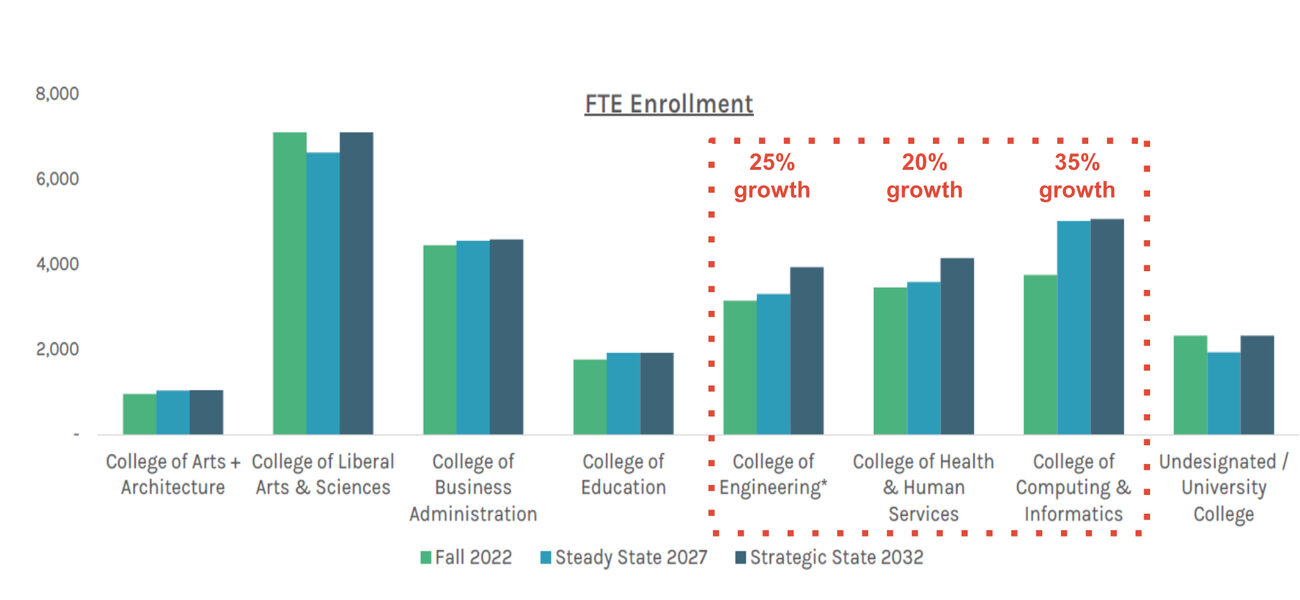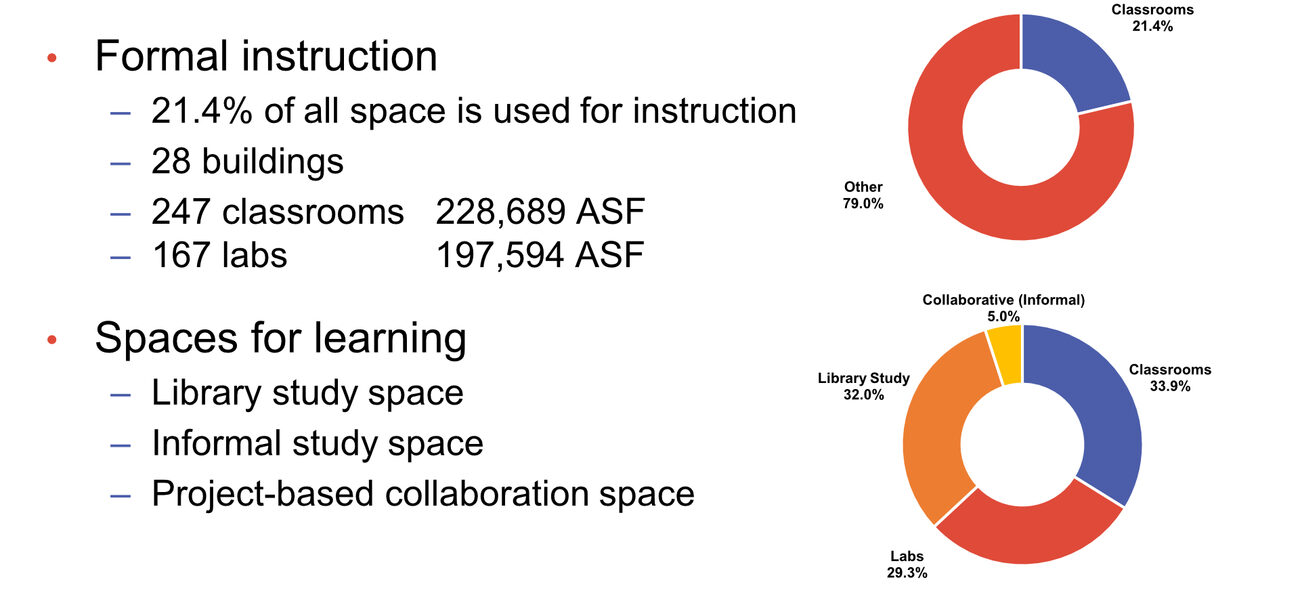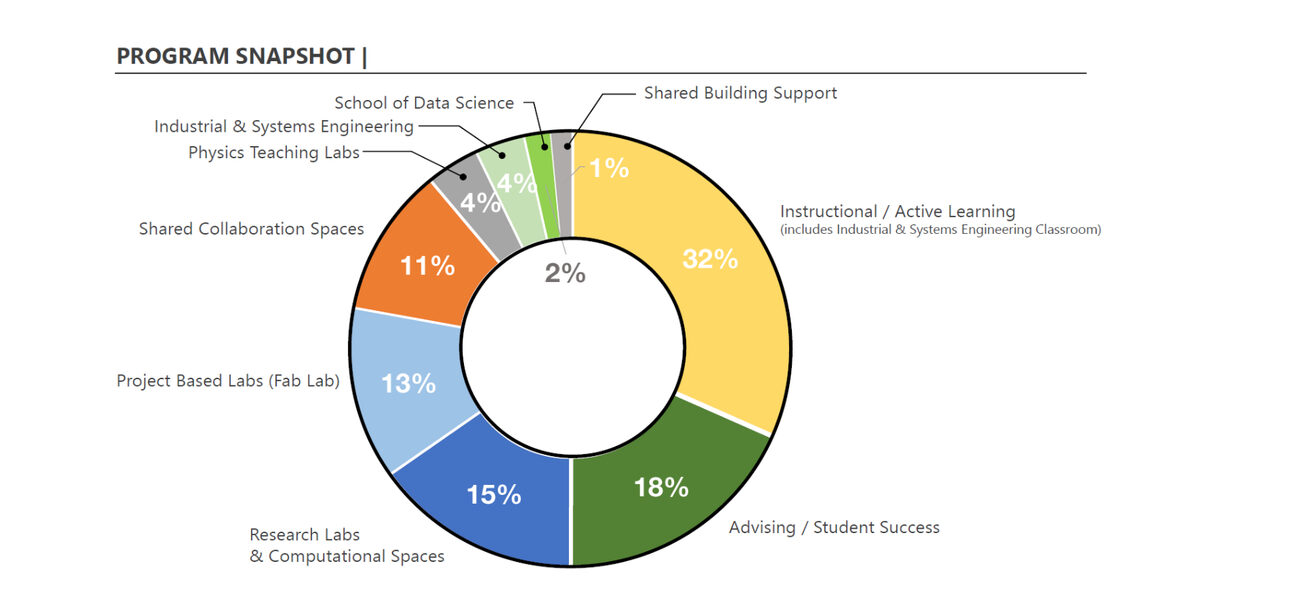How can learning environments be designed to best support teaching and learning for a growing student population in today’s economy? This is the overarching question driving the 2021-2031 classroom master plan to renovate teaching and learning facilities at the University of North Carolina (UNC) Charlotte, which serves 30,000 students as the third-largest university in the state.
While many other universities are following the national trend of enrollment declines or plateaus, enrollment at UNC Charlotte is projected to increase by 11% by 2031, to 33,024 undergraduate and graduate students, with 13% of projected enrollment growth in STEM disciplines. This projected growth is partly attributable to its location in one of the fastest-growing urban areas in the country.
The goal of the classroom master plan is to provide facilities to meet growing student demand while also adapting to a changing educational landscape. The priority is student success, a performance-based metric for a new funding model adopted in the 2022-2023 fiscal year by the UNC system and the UNC Board of Governors. Funding is tied to student success and graduation rates rather than just enrollment numbers. The goal is for more students to graduate on time with less debt.
What’s Changing in Higher Education
Beyond just graduating, “students want to learn the skills that will help them be relevant in the future,” says Kathryn Horne, the director of Planning, Design and Construction at UNC Charlotte.
But are universities actually delivering on this? A Gallup poll found that only 41% of students and just 11% of business leaders agree that colleges and universities are preparing students for the future, despite 96% of chief academic officers believing they are.
A national student experience survey by brightspot strategy reveals that students need more opportunities for real-world problem solving, teamwork, and flexible learning options. In fact, teamwork is the skillset most sought after by employers, according to a survey by the American Association of Colleges and Universities.
These needs are reflected in students’ preference for varied instructional formats. While the majority of instruction today is still delivered in a traditional lecture format, 63% of students prefer a combination of hybrid, blended, and hands-on experiences. Students prefer active over passing learning.
“Lectures are an efficient way for faculty to teach, but not always the best way for students to retain what they learn,” says Horne, though only 37% of students still prefer fully in-person classes.
Exploring Learning Spaces
To learn more about how to improve learning environments to support student success, UNC Charlotte launched a classroom study led by SmithGroup that features data on classroom utilization and quality, and emerging best practices in teaching and learning.
Importantly, the study highlights feedback from both students and faculty—the people who actually use these rooms. The responses from the campus community tell a compelling story about how learning is happening everywhere, not just in formal learning environments, and that spaces that facilitate active over passive learning are ideal.
An inventory of current space allocation at UNC Charlotte reveals that 21% of all space campuswide is used for formal instruction, meaning a classroom or lab where students take courses for academic credit. The space for formal instruction spans 28 buildings that house 247 classrooms (228,689 sf) and 167 labs (197,594 sf).
When learning space is considered more broadly to include both formal and informal spaces as a whole, classrooms comprise 34% of total learning space, while informal learning spaces make up the rest, including library study spaces (32%), project-based collaboration spaces (29%), and other informal study spaces (5%).
Not Enough of the Right Kind of Space
When it comes to formal instruction, it turns out that the university has more than enough space, yet it is not always the kind of space that students and faculty want or need. Some rooms are too crowded, while others are awkwardly laid out with fixed furniture that hinders teaching and learning. While there is a perception that more 60- to 100-seat classrooms are needed, the data shows that more course sections being taught needing only 21 to 50 seats.
Classroom utilization is another issue. On average, formal classrooms are being used only about three-quarters of the time they are available, which falls below state and national recommendations. The utilization issue partly stems from current scheduling policies, along with the fact that many students tend to register for classes primarily between 10 a.m. and 3 p.m., particularly to avoid early morning classes. Students also expressed a desire for more choice in class format, including in-person and online classes.
On the other hand, there doesn’t seem to be enough learning space outside the classroom, where more and more learning is occurring. As Horne explains, “I think there has been a misperception that when students are taking online courses, they are somewhere else, not on campus. But what we found is that a lot of students are on campus, trying to find whatever little nook or cranny, or space in the library, where they can participate in those classes.”
Whether a student is taking an online course or meeting with friends for a study session at the library, more of these informal learning spaces are needed throughout the campus, as there is 35% less study space and 21% less open lab space than guidelines recommend.
Interestingly, the library is one place outside the classroom where study space has increased, as a result of print material being removed during COVID, allowing for former stack space to be used for study.
More Power Outlets and Active Learning
As for what things look like inside these learning spaces, a qualitative evaluation of space utilization and classroom conditions (using the EDUCAUSE Learning Space Rating System) revealed that many classrooms are either in critical need of repair or overdue for renovation.
Qualitative needs include lighting, technology and power, thermal comfort, seating and writing surfaces, general condition, layout and furnishings, proportions and sightlines, and flexibility to support pedagogy.
Many students expressed a need for more power outlets to charge devices, as well as more writing surfaces, both on walls and on desks that are more substantial than the existing tablet-arm style.
Most faculty want more active learning classrooms, flexible furniture, technology to teach in hybrid modalities, and regular maintenance of all of the above. Instructors want to be able to move around a room to allow for small group discussions or group work.
The results of the classroom study yielded the following recommendations, which planners at UNC Charlotte will use to inform priorities and projects:
- Revise scheduling policy
- Right-size classroom inventory
- Build more active learning classrooms
- Increase the assignable square feet per student in classrooms
- Provide more informal study space
- Create more shared, project-based space, such as open labs
Strategies for Investment
With so much work that needs to be done, good financial stewardship is a key tenet of the new classroom plan. Given that the UNC system currently has a backlog of more than $6 billion in deferred maintenance costs across all campuses, the Board of Governors and the North Carolina General Assembly are focused on repairing and renovating existing facilities rather than new construction.
To accomplish their goals, UNC Charlotte planners have identified different levels of investment: stewardship, targeted renewal, funded projects, and capital plan projects.
The stewardship level involves keeping existing facilities in good condition by providing regular maintenance—for things like seating, technology, paint, and carpet—before anything becomes a major problem. This also includes small, informal funded projects that are completed during the summer.
At the targeted renewal level, the focus is on renovating any underperforming or underutilized spaces as active learning classrooms, project-based collaboration spaces, and informal study spaces.
Then there is the idea of “piggybacking” on already funded projects to design flexible, multi-use space. The library study space renovation is one project that will create more active learning spaces. Other ongoing projects are the Atkins Café and Prospector Hall dining facility, both of which are being redesigned so that seating is available to students even when the dining facility is closed.
Capital plan projects are the most comprehensive renovations and include the Burson, Smith, and Colvard buildings. The Burson Building, one of the older and more outdated buildings on campus, currently has $55 million of funding to completely renovate it and build an addition.
This building will be expanded to be a new teaching facility and interdisciplinary hub for the College of Engineering, the College of Computing and Informatics, and the School of Data Science, with an emphasis on enhancing the first-year experience. One-third of the building program will be dedicated to active learning classrooms, and the building will include a much needed project-based collaboration space.
Moving Forward
As the project moves forward, feedback from students and faculty will continue to play a vital role in determining areas of short- and long-term investment. A classroom committee made up of students and faculty will be established to bridge the gap among interested parties, and ultimately help build UNC Charlotte into a more successful community.
By Joy Lin



